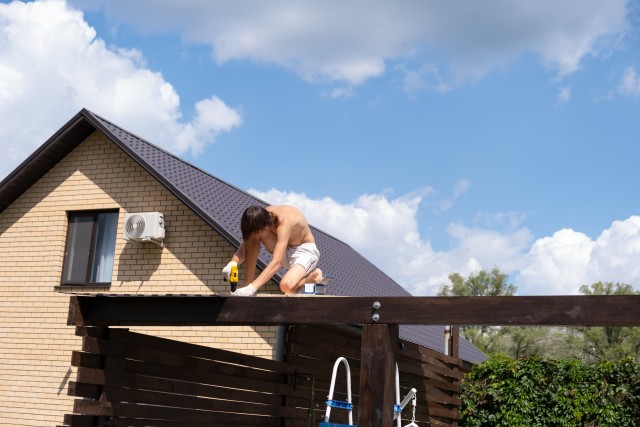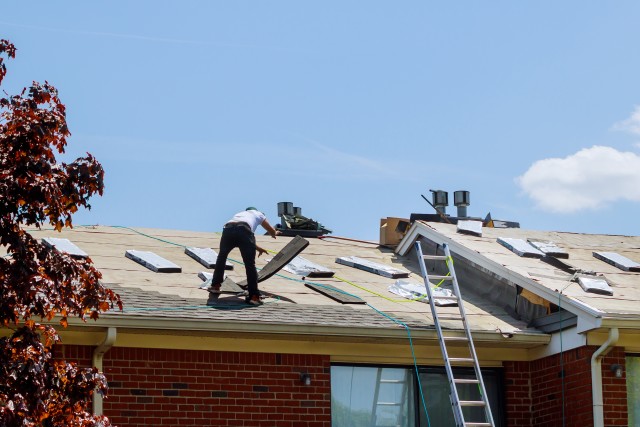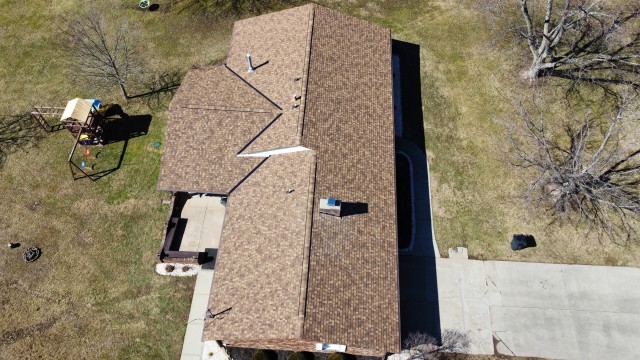Are you wondering if your Roof Needs Repair or Replacement? Knowing the signs of roof damage is crucial to maintaining a safe and protected home.
With age being a key indicator, keep an eye out for curling or missing shingles, leaks, and water damage, sagging or uneven areas, and increased energy bills.
Additionally, be aware of granule loss on shingles and the growth of moss or algae. Stay informed, stay powerful, and ensure the longevity of your roof.
Table of Contents
ToggleSigns of Roof Damage AND Roof Needs Repair or Replacement
If your roof has missing shingles or leaks, it’s a clear sign that it needs repair or replacement. Regular roof maintenance is essential to ensure its longevity and protect your property from potential damage.
DIY repairs can be a cost-effective option if the damage is minor and within your skill level. However, it’s important to assess the extent of the damage before attempting any roof repairs.
Inspect your roof regularly for signs of damage such as cracked or curling shingles, moss or algae growth, and sagging areas. These issues can compromise the integrity of your roof and lead to further damage if left unaddressed. Additionally, check for loose or damaged flashing around chimneys, vents, and skylights, as this can cause leaks.
When performing DIY repairs, ensure you have the necessary tools and safety equipment. Start by replacing missing or damaged shingles, securing loose ones, and cleaning any debris from the roof surface. Use roofing cement to seal any cracks or gaps, and replace damaged flashing if necessary. However, it’s important to note that more complex repairs, such as fixing structural issues or extensive leaks, should be left to professional roofers to ensure your safety and the effectiveness of the repairs.
Regular roof maintenance and timely DIY repairs can prolong the lifespan of your roof and prevent costly damage. However, if the damage is extensive or beyond your expertise, it’s recommended to consult a professional roofing contractor for a thorough inspection and professional repairs or replacement.
Age of Roof: A Key Indicator
One way to determine the age of your roof is by checking for any visible signs of deterioration. Roof maintenance is crucial to ensure the longevity of your roof. Understanding the age of your roof is an important factor in determining whether it needs repair or replacement. A well-maintained roof can last for decades, but eventually, it will show signs of wear and tear.
To determine the age of your roof, start by inspecting it for any visible signs of deterioration. Look for cracked or missing shingles, curling or buckling shingles, or areas where the granules have worn off. These are indicators that your roof may be nearing the end of its lifespan.
Roof lifespan varies depending on factors such as the type of roofing material used and the climate in which you live. Asphalt shingles typically last around 20 to 25 years, while metal roofs can last up to 50 years or more. However, these estimates are not set in stone and can be affected by factors such as the quality of installation and the level of roof maintenance.
Regular roof maintenance, such as cleaning gutters, removing debris, and inspecting for damage, can help prolong the lifespan of your roof. It’s recommended to have your roof inspected by a professional every few years to catch any potential issues early on.
Curling or Missing Shingles
Inspect your roof for any signs of curling or missing shingles as they can indicate that your roof may need attention. Curling shingles are a clear indication of wear and tear. Over time, the shingles can start to curl upwards or downwards, exposing the underlying layers to potential water damage. This can lead to leaks and structural issues if left unaddressed.
Missing shingles, on the other hand, create vulnerable spots on your roof where water can seep in and cause further damage. It is essential to replace these missing shingles promptly to prevent any potential water damage and maintain the integrity of your roof.
Curling and missing shingles are often caused by a variety of factors, including age, weather exposure, and poor installation. If you notice any signs of curling or missing shingles, it is recommended to contact a professional roofing contractor to assess the extent of the damage and provide the necessary repairs or replacements. Ignoring these issues can lead to more significant and costlier repairs down the line.
Regularly inspecting your roof for curling or missing shingles is crucial to ensure the longevity and protection of your home. By addressing these issues promptly, you can maintain a powerful and secure roof that withstands the elements with ease.
Leaks and Water Damage
Stains and discoloration on your roof can be indicators of potential issues that require attention. These unsightly marks can be caused by a variety of factors, such as algae growth, rust, or chemical reactions.
Mold and mildew, on the other hand, thrive in moist environments and can pose health risks if left untreated. It is important to address these problems promptly to prevent further damage to your roof and ensure a safe and healthy living environment.
Stains and Discoloration
If your roof has stains or discoloration, it might be a sign that it needs repair or replacement. Stains on your roof can be caused by a variety of factors, such as algae, moss, or lichen growth. These organisms thrive in moist environments and can damage the shingles on your roof.
To prevent these stains, regular roof cleaning is essential. Use a solution of water and bleach to remove the stains effectively. It is important to take safety precautions while cleaning the roof, such as using a sturdy ladder and wearing protective gear.
Additionally, trimming overhanging branches can help prevent debris from accumulating on your roof, which can lead to discoloration. By following these prevention tips, you can maintain the power and integrity of your roof for years to come.
Mold and Mildew
To prevent the growth of mold and mildew on your roof, it’s important to regularly clean and maintain it. Mold and mildew can not only damage your roof, but they can also pose serious health risks to you and your family.
Here are some important tips for mold prevention:
– Keep your roof clean by regularly removing debris such as leaves and branches.
– Ensure proper ventilation in your attic to prevent moisture buildup.
– Repair any leaks or damage in your roof promptly to prevent water from seeping in and creating a breeding ground for mold.
– Consider using mold-resistant materials when replacing or repairing your roof to reduce the risk of mold growth.
Sagging or Uneven Roof
If you notice that your roof is sagging or uneven, it’s important to understand the causes behind this issue. Sagging can occur due to structural problems, such as weakened or damaged support beams, or excessive weight from snow or debris.
When it comes to addressing this issue, you may need to decide between repairing the affected areas or opting for a complete roof replacement. However, it’s strongly recommended to seek the expertise of a professional inspector who can accurately assess the extent of the damage and provide the most suitable course of action.
Causes of Sagging
One of the common causes of a sagging roof is the weight of accumulated snow or ice. If your area experiences heavy snowfall or frequent freezing temperatures, it is essential to monitor the weight on your roof to prevent structural damage.
The weight of snow or ice can exceed the load-bearing capacity of your roof, leading to sagging or even collapse. Regular maintenance is crucial in identifying and addressing potential issues before they escalate. By conducting routine inspections and taking proactive measures, such as removing excess snow or ice buildup, you can ensure the longevity and structural integrity of your roof.
Neglecting regular maintenance can result in costly repairs or the need for a complete roof replacement, emphasizing the importance of staying vigilant and taking timely action.
Repairing Vs. Replacing
You can save money and extend the lifespan of your roof by considering whether repairing or replacing is the best option for addressing any issues.
When it comes to repair options, it’s important to assess the extent of the damage. Minor issues like loose or missing shingles can often be fixed with simple repairs. However, if your roof has significant damage, such as widespread leaks or structural issues, it may be more cost-effective to opt for a full replacement.
When making this decision, it’s crucial to do a cost comparison. Consider the cost of repairs over time versus the upfront investment of a replacement. Additionally, factor in the potential energy savings and increased property value that a new roof can provide.
Professional Inspection Recommended
Consider scheduling a professional inspection to determine the condition of your roof and whether it requires any maintenance or replacement. A roof inspection conducted by a qualified professional can provide you with valuable information and a comprehensive assessment of your roof’s current state.
Here are three reasons why a professional inspection is highly recommended:
– Expertise: A professional inspector has the knowledge, skills, and experience to thoroughly evaluate the condition of your roof. They can identify potential issues that may not be visible to an untrained eye.
– Safety: Climbing up on your roof can be dangerous, especially if you’re not familiar with proper safety precautions. Letting a professional handle the inspection ensures your safety and eliminates the risk of accidents.
– Professional Opinion: A professional inspector can provide you with an unbiased assessment and offer recommendations based on their expertise. Their opinion can help you make informed decisions regarding any necessary repairs or replacements.
Don’t underestimate the importance of a professional roof inspection. It’s a powerful tool that can give you peace of mind and help you maintain the integrity of your home.
Increased Energy Bills
If your energy bills have been going up, it’s possible that your roof may need repair or replacement. A deteriorating roof can lead to increased energy bills due to poor insulation and ventilation. When your roof is damaged or worn out, it can allow air to escape, causing your heating or cooling system to work harder to maintain a comfortable temperature. As a result, you end up using more energy and facing higher utility bills.
Not only does a damaged roof impact your energy bills, but it can also have a significant impact on the overall value of your property. A roof in poor condition can be a red flag for potential buyers, as it suggests that the property has not been well-maintained. It can decrease the curb appeal and make it harder to sell your home at a desirable price. Therefore, addressing any issues with your roof promptly is essential to maintain the value of your property.
To determine if your roof needs repair or replacement, it is recommended to consult with a professional roofing contractor. They can assess the condition of your roof, identify any underlying issues, and provide you with the necessary solutions. Remember, a well-maintained roof not only saves you money on energy bills but also protects the overall value of your property.
Granule Loss on Shingles
Examine your roof shingles closely for any signs of granule loss. Granules are the small, protective particles on the surface of your shingles that play a crucial role in shielding your roof from the elements. If you notice significant granule loss, it could indicate that your roof is in need of repair or even replacement. Granule loss can occur due to aging, weathering, or poor-quality shingles. When granules are worn away, the underlying asphalt is exposed, leading to accelerated deterioration and potential leaks.
To address granule loss and ensure the longevity of your roof, there are several repair options and maintenance tips to consider. One option is to have a professional roofer assess the extent of the damage and recommend appropriate repairs. This may involve replacing individual shingles or sections of your roof to restore its integrity and protect against further granule loss.
In terms of maintenance, regular roof inspections are crucial. Perform visual checks at least twice a year, paying particular attention to areas prone to granule loss, such as roof valleys or areas directly exposed to sunlight. Additionally, keep your gutters clean to prevent debris buildup that can contribute to granule loss.
Moss or Algae Growth on Roof
To prevent moss or algae growth on your roof, regularly clean your gutters and trim overhanging tree branches. Moss and algae can cause damage to your roof, leading to costly repairs or even the need for a replacement.
Here are three effective methods for moss removal and prevention:
1. Chemical Treatments: Apply a moss-killing solution to your roof to eliminate existing moss and prevent future growth. These treatments typically contain zinc or copper, which are toxic to moss and algae. Follow the manufacturer’s instructions carefully and ensure the solution is safe for your specific roofing material.
2. Physical Removal: If you notice moss growth on your roof, it’s crucial to remove it promptly. Use a stiff brush or broom to scrub away the moss, taking care not to damage the shingles. You can also use a pressure washer on a low setting, but be cautious not to dislodge or damage any roofing materials.
3. Regular Maintenance: The best way to prevent moss and algae growth is to maintain a clean and well-maintained roof. Regularly clean your gutters to prevent debris buildup, which can create a conducive environment for moss growth. Additionally, trim overhanging tree branches to allow sunlight and airflow to reach your roof, as moss thrives in shaded and damp areas.
Conclusion
In conclusion, it’s crucial to be aware of the signs that indicate your roof may need repair or replacement.
Pay attention to the age of your roof, as it’s a key indicator of potential damage. Look out for curling or missing shingles, leaks and water damage, and a sagging or uneven roof.
Additionally, increased energy bills and granule loss on shingles are red flags. Lastly, be mindful of any moss or algae growth on your roof.
By being proactive and addressing these issues promptly, you can ensure the longevity and functionality of your roof.





